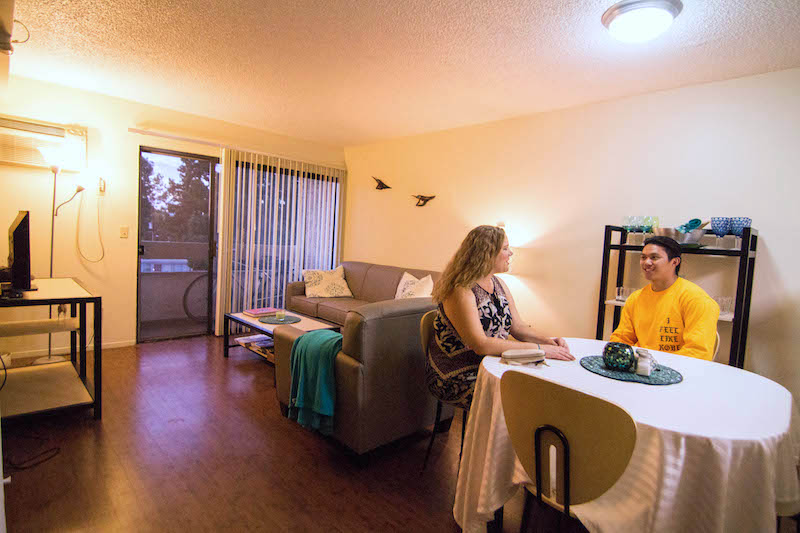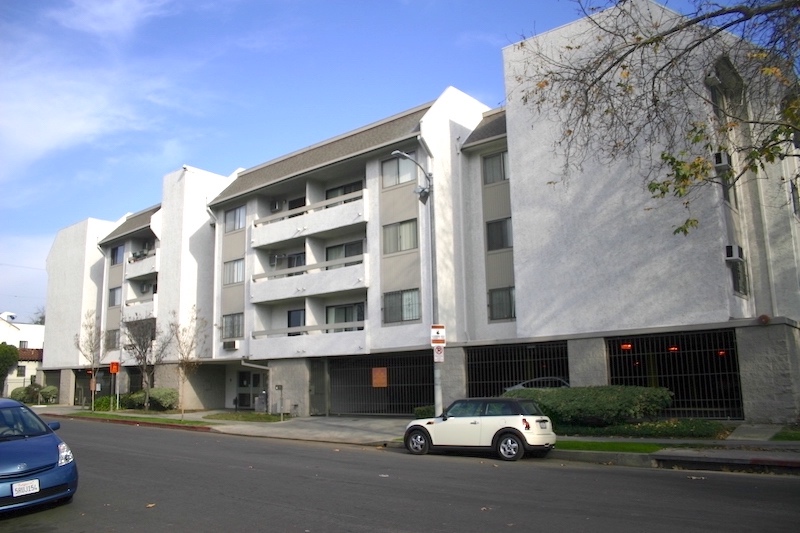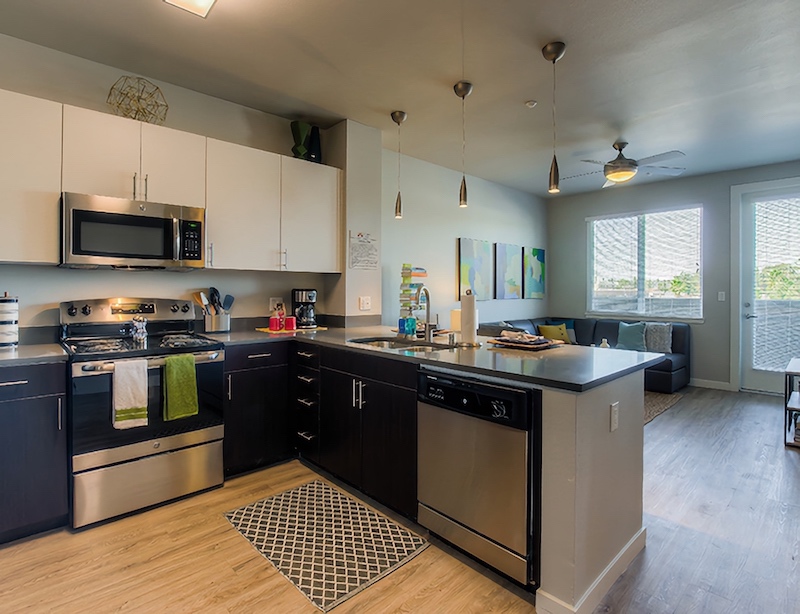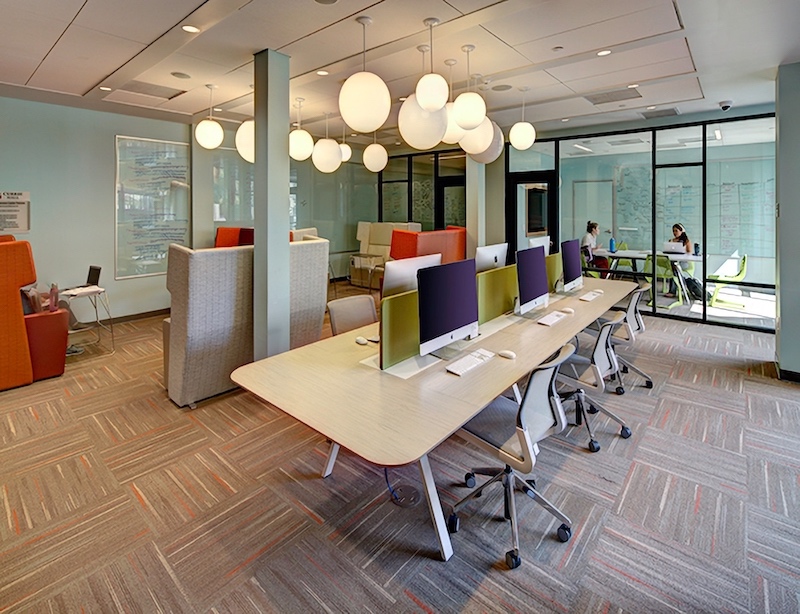Student Blog
Housing and Transportation

Los Angeles Living! ⟩
February 9, 2018, by Ali
Housing and Transportation Living in LA
The ambassadors and I have been receiving a lot of questions about where we live in Los Angeles to commute to the Health Science Campus (HSC) for class! I wanted to shed some light on my living situations and hopefully answer some of your questions.
My first year in the program I lived in a house within a five minute walking distance to the University Park Campus (UPC). I loved living near the main campus of USC with the undergraduate community I still wanted to be a part of. Around the main campus there is the new campus village which has everything from Target to Trader Joes to two Starbucks locations! I took the USC Intercampus Shuttle to and from the main campus to the Health Science Campus each day. The shuttle was convenient and a great place to take a nap or finish up some last minute homework. Living near the main campus was great for me because I loved running around that campus and taking the ten minute drive to downtown LA for some great food and nightlife! The OT House is also located near UPC, so there was a lot of OT friends nearby which is always great. See Caroline’s post to read more about the OT house!
For my second year I decided to move to Palms, which is a small neighborhood on the Westside of Los Angeles. The rent is affordable and I love being closer to the beach as well as the benefits of learning a whole new part of Los Angeles. My commute ranges from twenty minutes to fifty minutes by car depending on traffic. Although I am from a small suburb in Sacramento, California, I am already used to the traffic that Los Angeles throws at us. I’ve learned that leaving at 7pm versus 5pm can make the world of difference. I either stick around campus after class and study at the library to wait for traffic to die down or I turn on a podcast and use the longer drive as a time to recharge alone! I also live right on by a metro stop and can take the metro to explore LA easily, which is an added bonus to my relocation. To read more about moving to LA and navigating a this city without a car read Linah’s post! Living in Palms has also been a nice change because it is a little further form downtown so there is less congestion around my apartment and it feels more like a neighborhood!
USC OT students live all over Los Angeles. People live anywhere from across the street in Currie Hall (Pro tip: see Kaitlyn’s post about living in Currie Hall!) to Orange County. Everyone has his or her own solution to find the right space and place in order to be successful in graduate school. If you have any questions about housing please feel free to reach out!
⋯

OT House Pros and Cons ⟩
February 7, 2018, by Caroline
Housing and Transportation
This blog is dedicated to a building that I spend a lot of time in: The OT House. Although I don’t actually live in the OT House (I live in an apartment in Pasadena), most of my friends do, so it’s become a second home for me. Linah offered some advice about finding housing in LA and Kaitlyn wrote about Currie Hall, a graduate student housing option on the Health Sciences campus, so here’s one more housing perspective. The OT House (officially named Centennial Apartments) is a graduate student apartment located near the USC University Park Campus. Each unit is a 2 bedroom, 1 bathroom apartment with a kitchen, living room, and balcony. The building has a communal outdoor patio with lounge chairs and a grill. A gym is located in the basement with cardio equipment (2 treadmills, 2 ellipticals) as well as two benches with free weights. There is a communal lounge on the first floor with a large TV and table space to study with a group. Washers and dryers are available on every floor.
I polled a few friends (shout out to Brooke, Heather, Hanna, Emily, and Brett!) to get some Pros and Cons about living in the OT House, so here we go:
Pros
- Location
The OT House is a short walk to USC’s University Park Campus — easy access to the libraries and fun events on campus. The Village, a new complex with a Trader Joe’s, Target, restaurants, and a gym is also a short walk away. Additionally, the OT house is centrally located in Los Angeles, a short drive to downtown and 30 minutes away from the beach! - Great for Students without a Car
There is an inter-campus tram that picks students up right in front of the OT House in the morning and drops students off on the Health Science campus, where all of our classes take place. It’s a quick 30 minute ride — no need to have a car or deal with navigating traffic to get to school in the morning! The OT house is also within the Campus Cruiser boundaries; from 7PM-2AM students can take a free Lyft ride to anywhere else within the boundary. There are a couple of metro stops near the OT House, which students can use to commute to Fieldwork if they don’t have a car. - Safety
The building is very secure! You have to swipe into the building entrance AND swipe into the elevator. Only residents of the building are able to enter. A key is required to enter each floor using the stairs, and doors are locked with a key. In the event of an emergency, campus security is a quick phone call away. - Community
Living with fellow OT students is a great way to make friends and study partners! There is a Resident Advisor who plans various events for the building (most recently, trivia), and there is an OT Faculty Advisor, currently Dr. Kim Lenington, who lives at the OT house (with her very cute dog, Barney) and is available to spend time with and support students living at the OT House. I’m an “honorary” member of the OT House Facebook group, and I’ve attended a lot of fun gatherings at the OT House: 4th of July barbeque, superbowl party, holiday gift exchange, a wine and cheese sampling soiree, and so much more! Additionally, Engage is a weekly community outreach program hosted at the OT House. It’s a fun way to connect with and mentor children and young adults in the community, with games, activities, and dinner. - General Apartment Setup
The OT House is FULLY furnished: table and chairs in the dining area; couch, chair, and tables in the living room; bed, desk, and storage drawers in the bedroom (and sizable closets); fridge/freezer, oven, stove, and dishwasher in the kitchen (no microwave provided). For anyone moving to LA to start the program, this makes the move significantly easier — no furniture shopping or movers to deal with! Though the bathroom is shared, there are 2 sinks and the toilet and shower are in separate rooms, making it an easy set-up for a shared bathroom. The apartment has A/C, and you can control your own air in each of the bedrooms — negates the awkward thermostat debates with your roommate. - Cost and Housing Timeline
The 2018-2019 monthly rate per person will be $1,235, which is pretty competitive for Los Angeles. The housing contract lines up with the USC academic year — students can live there August-May and can do a summer contract May-August. This summer option is nice, as some students will choose to live in the OT House their first summer in the program, meet some friends, settle in and learn the LA area a little better, and then move to a different housing location for the fall. For students interested in doing Level II Fieldwork out of area during the summer, they don’t have to deal with paying for rent in two places or finding someone to sublet while they’re away.




Cons
- Wear and Tear
The OT house is not a new building. If you’re looking for a super sleek and modern apartment, this is not it — it’s got some character though (in fact, some of our professors lived in the OT house when they were in the Master’s program . . . looking at you, Dr. Rafeedie!). To be clear, the OT House is not gross or falling apart, it’s just not a new building! If maintenance problems do come up, like a fire alarm battery that needs replacing or a toilet that needs unclogging, maintenance acts quickly and thoroughly. One of my friends living at the OT House even called maintenance for help when she saw a spider in her room (maintenance was very nice about it, and she’s working on her fear of spiders. We’re supporting her through it 😊) - Hidden Fees
The OT House has secure parking beneath and behind it, but it’s not free. Students living at the OT House pay $75/month for parking. There are washer/dryer units on each floor of the building, but those aren’t free either: the washer is $1.50 per load and the dryer is $1 per load. - Printing and Package Pickup
There is not a communal printer in the OT House; the closest one is in Sierra, another apartment building, which is a 5 minute walk away. Students get 50 pages of printing free per year. Packages deliveries are also sent to Sierra, which is not open late at night. Timing package pick up around the class schedule has been a complaint from my friends who live at the OT House. - The Shuttle Route
When taking the inter-campus shuttle back home at the end of the day, the route changes a little bit. It does not drop students back off right in front of the OT House. The closest stop in the afternoon is a 15-minute walk away from the OT House. Sure, I could spin it and say it incorporates a little activity into your day and allows you to hang out with friends and debrief the school day, but let’s be real. Sometimes at the end of the day, you just want to plop onto the couch, watch some TV, and not talk to anyone, and this added time to the commute delays that.
I’ve made a lot of great memories in the OT House, so I’m definitely partial to it, but there’s a lot to consider when deciding where to live. You can find more information about the OT House on our website and on the USC housing website. Hopefully this helps those of you thinking about the transition to LA!
⋯

Housing 101 ⟩
January 29, 2018, by Linah
Housing and Transportation Living in LA
Moving to a new city is daunting, let alone a new country (In my case). Before venturing to find housing, I think it is important to gauge your exact needs as a MA student before committing to anything. If you are planning to stay in student housing offered by USC, start as early as possible in order to find a space. However, if you plan to stay off campus, then take your time before signing any leases. You would find better options when looking in person than online, but do not scratch off the online hunt just yet because Facebook is full of USC student groups with ads by Trojans who are looking for roommates or to sublease their apartments.
A tip that most students do before settling on an apartment is to rent a place for short stay or stay with friends or family for the first couple of weeks and look for an apartment physically. During the first few weeks, you will know what your class schedule is, and get a sense of how much time you will need on campus, and even get a chance to prioritize the apartment features you will need as an MA student. For example, knowing what time you finish classes at the end of the day could help you determine whether or not you need a car. If you spend long hours on campus but finish early, perhaps using public transportation would be wiser to avoid traffic. If your classes are more spread out through the day and you finish at night, then getting a car would be the wiser choice since it would be safer.
Location, location, location!
A well located apartment is way better than an apartment with a lot of amenities. Both are important, but in the long run being closer to public transportation, school/work, grocery stores, pharmacies, etc, will prove to be more helpful than having an en suite washer/dryer or whatever. When visiting prospective apartments, use Google maps to check the duration of the commute to campus and vice versa. Almost all housing offered by the university is close to the main campus. As an MA student, most if not all classes will be on the Health Sciences Campus. So, choosing to live on the main campus will mean a daily 40 minute commute to Health Sciences Campus (or 20 minutes if you’re driving). This should be taken into account as well as how close are other services to the apartment, like grocery stores or pharmacies or quick bite restaurants. A good tip for this is to use Yelp or Foursquare to see what is near your prospective apartment. Nobody wants to end up stranded or commuting just for groceries at the end of a long day.
Spending extra on rent might mean saving money in the long run
A well located apartment that includes utilities will be expensive. However, a cheaper apartment that is far and does not offer any amenities will cost more on the long run because you will have to compensate for what the apartment lacks with your own money. For example, splurging a bit on rent and getting an apartment that is close to a metro station, includes utilities, and offers maintenance services, and parking for free will relieve you from needing a car for everything, or paying for parking, gas, electricity or even buying some household appliances. Of course, this all depends on your living needs in LA. So, doing the math beforehand is the only way to determine if this will help you cut costs or not. Also, how long you intend to stay in LA is a contributing factor as well when it comes to deciding how long is your “long run”.
Car or no car?
I think this decision depends on your budget, class schedule, and how close to public transportation you are. For budgeting, bear in mind that a car in LA is very useful but can be expensive. The cost does not only entail the actual cost of the car or its rent, but also parking fees, parking permits, gas money, insurance, and possible maintenance fees. All these costs will pile up at the end of every month, and it is important to make sure that your budget can handle it.
If you decide to opt out of getting a car, then USC has got you covered! The USC shuttle covers all USC campuses and is free of charge for all Trojans. The bus routes conveniently pass through Union Station which is one of the biggest train stations in LA that connects most metro lines. As a USC student you could also get a UPass, which is a metro card that is purchasable at a discounted flat rate at the beginning of every semester. I understand that LA has a reputation of being an “unwalkable” city, but since the Health Science Campus is located so close to downtown LA, public transportation suffices.
⋯

Currie Hall (No Affiliation with Food nor the NBA) ⟩
January 8, 2018, by Kaitlyn
Housing and Transportation Living in LA
After high school, I moved out to downtown Los Angeles to attend USC for undergrad and lived there for four years. Once I decided that I was going to go continue at USC (but this time on the Health Sciences Campus), I knew that it was the perfect time to move and make a (slight) change.
I am a big believer in growing wherever you are planted. Thus, finding the right place to live is imperative to me in so many ways. Is it reasonably close to friends and family? Is it safe? Is it comfortable? Are there opportunities for socialization in the nearby area? Are there good restaurants (huge food lover here) around?! There are a lot of considerations when finding a new place to live and I wanted to make the right choice as I embarked on this new journey.

I had a few options in mind, but I ultimately decided to move into an apartment building located on the USC Health Sciences Campus called Currie Hall. I moved there on the first day it opened, so I’ve been living there for about a year and a half now. If you’re interested in moving in, the following are some pros and cons.
Pros:
The “commute” — My commute is about a 5-minute walk across the street to the Center for Health Professions building. It sure beats sitting in traffic for an hour, that’s for sure!
The residents — Almost everyone in the building is a student on the USC Health Sciences Campus. Thus, you’ll run into medical, physical therapy, and pharmacy (just to name a few) students all the time! It’s in the norm to see people walking around in scrubs and/or a white coat. It’s a great experience to be in such a interdisciplinary housing setting filled with future healthcare professionals! I personally live with a pharmacy student and a medical student!
Safety — I feel very safe in this building. There are many “checkpoints” at every doorway/entryway where your key is required. DPS is also only just a phone call away if they’re ever needed!
Proximity to “new” cities — I frequent the Arts District, Silver Lake, Echo Park, Downtown, and Pasadena quite frequently because they are all within close driving distance (this also means cheap Ubers/Lyfts)! All of the cities I just mentioned have different “personalities,” so it’s nice to feel like I’m still exploring new places around LA. *Tip: Arts District, Silver Lake, and Echo Park have amazing hidden gems when it comes to restaurants so definitely keep your options open! My current favorites are Mohawk Bend and Cliff’s Edge (again, big food lover here).
The apartment & building itself — Like I mentioned before, I moved in the first day it opened so it is BRAND NEW. Some notable perks: an in-unit washer/dryer (a life saver!), a balcony, your own bathroom, your own walk-in closet, furnished when you move in, a gym, a BBQ grill/patio area, a pool and jacuzzi, study rooms, etc. The staff is also great as well!
Cons:
Far from the beach — Unfortunately, it is far from the beach, which is one of my greatest loves! With traffic, it takes me about 45 minutes to get to the coastline. I also have friends that live on the west side of Los Angeles (i.e. Santa Monica, Culver City) so it can be inconvenient at times to get to them.
Everything is within some kind of driving distance — Although it is the most convenient option when it comes to school, it is not the most convenient when it comes to going to the store or running errands. For example, Trader Joe’s and Target are about a 15 minute drive away in the neighboring cities. Sometimes this feels a bit isolating, but it hasn’t bothered me too much because I have a car.
Holiday Breaks=Ghost Town — It is eerily empty when winter, summer, and spring breaks roll around because most residents go home for the holidays!
“Dorm”-like? — I have to agree and disagree on this one. Yes, it does feel like a dorm in that everyone there is a student but we are also all graduate students. This means that we’re all busy — studying, going off to clinical rotations, working . . . you name it! We’ve got a lot of responsibilities on our plate so you definitely won’t get those freshman dorm experiences you had in college.


I may have picked the closest option to campus, but don’t be afraid to venture out as well! I have many friends who commute from neighboring cities like Silver Lake, Echo Park, Alhambra, Pasadena, and Downtown. I know people who commute from Culver City, Manhattan Beach, and Santa Monica as well! My best piece of advice: Determine what’s important to you and pick a place you know you will be happy in.
If interested in learning more about Currie Hall, click here.
⋯

Some Alternative Transportation ⟩
December 1, 2017, by Bryan
Housing and Transportation Living in LA
I thought this post might be useful for anyone considering applying/attending USC who lives outside the LA area! I currently live in Redondo Beach and driving to campus is definitely taxing. It takes a little over an hour each way and there are plenty of cohort members who commute all the way from the OC! For those who are looking for some alternative and cheaper forms of transportation/parking, here are a few.
- Metrolink Trains. A number of my cohort members take this train from Fullerton/Irvine/OC area and it is a great option! The train has seats to sit on and study or sleep and also travels straight to Union Station, from which you can board a USC shuttle to take you to Health Science Campus. The downside with these trains is that the departure times are pretty limited so you will probably have to wake up pretty early and leave campus by specific times.
- Metro Bus. I personally take the silver line 910/950 which goes straight from Gardena area/91 fwy entrance in the South Bay all the way to LA+USC Hospital which is close to the Health Science Campus! The commute consists of just one bus and takes about ~1hr to get to HSC. A major benefit is that the Tap Card bus pass (which works for all other Metro lines as well!) is 107$/semester. You can purchase a Tap Card online through USC and pick up the sticker on HSC campus.
If you do end up driving and are looking for other potential parking options, there is metered parking available on campus that expire in 4 hour intervals (1$/hr) as well as free parking available on Valley Street right next to campus, across the train tracks. If you search “Lincoln Park” into your maps app, you can find free street parking around that area. Finding street parking along Valley gets tough, however, so definitely give yourself some time to find a spot and walk to class.
Hope this makes your commuting lives a little easier!
⋯





